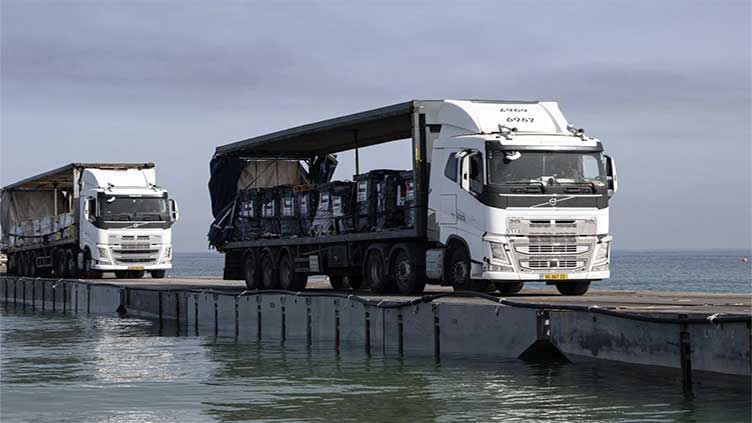US military pier for carrying aid to Gaza will be dismantled

World
Critics call the pier a $230 million boondoggle that failed to bring in the level of aid needed
WASHINGTON (AP) — The US military-built pier to carry humanitarian aid to Gaza will be dismantled and brought home, ending a mission that has been fraught with repeated weather and security problems that limited how much food and other supplies could get to starving Palestinians.
Vice Adm. Brad Cooper, deputy commander at US Central Command, told reporters in a Pentagon briefing on Wednesday that the pier achieved its intended effect in what he called an “unprecedented operation.”
As the US military steps away from the sea route for humanitarian aid, questions swirl about Israel’s new plan to use the port at Ashdod as a substitute. There are few details on how it will work and lingering concerns about whether aid groups will have enough viable land crossings to get assistance into the territory besieged by war between Israel and Hamas.
Cooper said the Ashdod corridor will be more sustainable and it has already been used to get more than a million pounds of aid into Gaza.
“Having now delivered the largest volume of humanitarian assistance ever into the Middle East, we’re now mission complete and transitioning to a new phase,” said Cooper. “In the coming weeks, we expect that millions of pounds of aid will enter into Gaza via this new pathway.”
He said there is currently 5 million pounds of aid in Cyprus, awaiting transit to Ashdod, and they expect delivery to start “in the coming days.”
Sonali Korde, assistant to the administrator of United States Agency for International Development’s Bureau for Humanitarian Assistance, told reporters that aid groups have confidence that “Ashdod is going to be a very viable and important route into Gaza.”
But, she said, “the key challenge we have right now in Gaza is around the insecurity and lawlessness that is hampering the distribution once aid gets into Gaza and to the crossing points.”
Israel controls all of Gaza’s border crossings and most are open.
Critics call the pier a $230 million boondoggle that failed to bring in the level of aid needed to stem a looming famine. The US military, however, has maintained that it served as the best hope as aid only trickled in during a critical time of near-famine in Gaza and that it got close to 20 million pounds (9 million kilograms) of desperately needed supplies to the Palestinians.
President Joe Biden, who announced the building of the pier during his State of the Union speech in March, expressed disappointment in the pier, saying, “I was hopeful that would be more successful.”
Planned as a temporary fix to get aid to starving Palestinians, the project was panned from the start by aid groups that condemned it as a waste of time and money. While U.S. defense officials acknowledged that the weather was worse than expected and limited the days the pier could operate, they also expressed frustration with humanitarian groups for being unable and unwilling to distribute the aid that got through the system, only to have it pile up onshore.
A critical element that neither the aid groups nor the US military could control, however, was the Israeli defense forces whose military operation into Gaza put humanitarian workers in persistent danger and in a number of cases cost them their lives.
As a result, the pier operated for fewer than 25 days after its installation May 16, and aid agencies used it only about half that time due to security concerns.
Stuck in the middle were the more than 1,000 US soldiers and sailors who largely lived on boats off the Gaza shore and struggled to keep the pier working but spent many days repairing it or detaching it, moving it and reinstalling it due to the bad weather.
Cooper declined to provide any details on how or when the troops would return home.
The tensions played out until the final moments, as senior Biden administration officials signaled the end of the pier project days ago but US Central Command balked, holding out hope the military could reinstall it one last time to move any final pallets of aid ashore.
Most would agree that use of the maritime route and what is known as the Army’s Joint Logistics Over the Shore capability, or JLOTS, fell short of early expectations. Even at the start, officials warned of challenges because the sea is shallow, the weather is unpredictable and it was an active war zone.
The US also had to train Israeli troops and others on how to anchor the pier to the shore because no US troops could step foot on Gaza soil, a condition Biden has had since the beginning of the Hamas-Israel conflict in October.
However, enough aid to feed 450,000 people for a month flowed through the pier, according to USAID, which coordinated with the United Nations and others to get supplies to people in need. As important, humanitarian leaders say, the pier operation laid the groundwork for a coordination system with the Israeli government and military that they can expand on.


